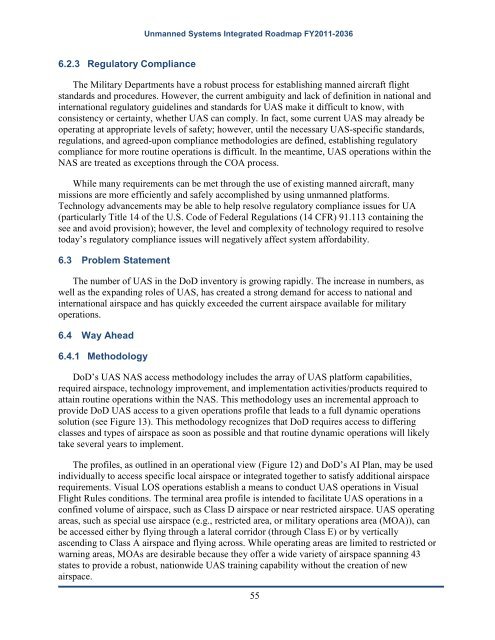Unmanned Systems Integrated Roadmap FY2011-2036 - Defense ...
Unmanned Systems Integrated Roadmap FY2011-2036 - Defense ...
Unmanned Systems Integrated Roadmap FY2011-2036 - Defense ...
You also want an ePaper? Increase the reach of your titles
YUMPU automatically turns print PDFs into web optimized ePapers that Google loves.
6.2.3 Regulatory Compliance<br />
<strong>Unmanned</strong> <strong>Systems</strong> <strong>Integrated</strong> <strong>Roadmap</strong> <strong>FY2011</strong>-<strong>2036</strong><br />
The Military Departments have a robust process for establishing manned aircraft flight<br />
standards and procedures. However, the current ambiguity and lack of definition in national and<br />
international regulatory guidelines and standards for UAS make it difficult to know, with<br />
consistency or certainty, whether UAS can comply. In fact, some current UAS may already be<br />
operating at appropriate levels of safety; however, until the necessary UAS-specific standards,<br />
regulations, and agreed-upon compliance methodologies are defined, establishing regulatory<br />
compliance for more routine operations is difficult. In the meantime, UAS operations within the<br />
NAS are treated as exceptions through the COA process.<br />
While many requirements can be met through the use of existing manned aircraft, many<br />
missions are more efficiently and safely accomplished by using unmanned platforms.<br />
Technology advancements may be able to help resolve regulatory compliance issues for UA<br />
(particularly Title 14 of the U.S. Code of Federal Regulations (14 CFR) 91.113 containing the<br />
see and avoid provision); however, the level and complexity of technology required to resolve<br />
today’s regulatory compliance issues will negatively affect system affordability.<br />
6.3 Problem Statement<br />
The number of UAS in the DoD inventory is growing rapidly. The increase in numbers, as<br />
well as the expanding roles of UAS, has created a strong demand for access to national and<br />
international airspace and has quickly exceeded the current airspace available for military<br />
operations.<br />
6.4 Way Ahead<br />
6.4.1 Methodology<br />
DoD’s UAS NAS access methodology includes the array of UAS platform capabilities,<br />
required airspace, technology improvement, and implementation activities/products required to<br />
attain routine operations within the NAS. This methodology uses an incremental approach to<br />
provide DoD UAS access to a given operations profile that leads to a full dynamic operations<br />
solution (see Figure 13). This methodology recognizes that DoD requires access to differing<br />
classes and types of airspace as soon as possible and that routine dynamic operations will likely<br />
take several years to implement.<br />
The profiles, as outlined in an operational view (Figure 12) and DoD’s AI Plan, may be used<br />
individually to access specific local airspace or integrated together to satisfy additional airspace<br />
requirements. Visual LOS operations establish a means to conduct UAS operations in Visual<br />
Flight Rules conditions. The terminal area profile is intended to facilitate UAS operations in a<br />
confined volume of airspace, such as Class D airspace or near restricted airspace. UAS operating<br />
areas, such as special use airspace (e.g., restricted area, or military operations area (MOA)), can<br />
be accessed either by flying through a lateral corridor (through Class E) or by vertically<br />
ascending to Class A airspace and flying across. While operating areas are limited to restricted or<br />
warning areas, MOAs are desirable because they offer a wide variety of airspace spanning 43<br />
states to provide a robust, nationwide UAS training capability without the creation of new<br />
airspace.<br />
55

















